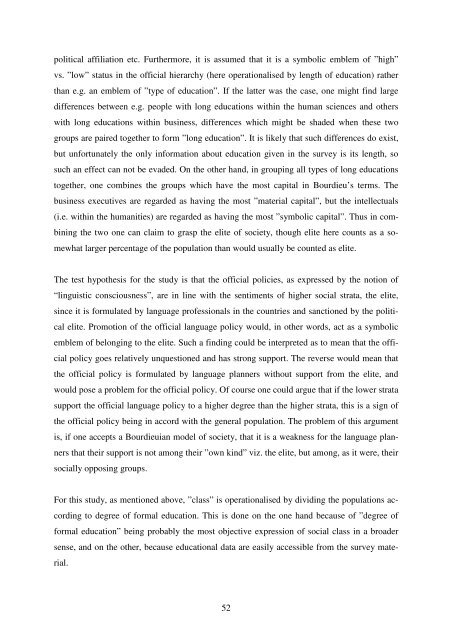Hør dog hvad de siger - Note-to-Self: Trials & Errors
Hør dog hvad de siger - Note-to-Self: Trials & Errors
Hør dog hvad de siger - Note-to-Self: Trials & Errors
Create successful ePaper yourself
Turn your PDF publications into a flip-book with our unique Google optimized e-Paper software.
political affiliation etc. Furthermore, it is assumed that it is a symbolic emblem of ”high”<br />
vs. ”low” status in the official hierarchy (here operationalised by length of education) rather<br />
than e.g. an emblem of ”type of education”. If the latter was the case, one might find large<br />
differences between e.g. people with long educations within the human sciences and others<br />
with long educations within business, differences which might be sha<strong>de</strong>d when these two<br />
groups are paired <strong>to</strong>gether <strong>to</strong> form ”long education”. It is likely that such differences do exist,<br />
but unfortunately the only information about education given in the survey is its length, so<br />
such an effect can not be eva<strong>de</strong>d. On the other hand, in grouping all types of long educations<br />
<strong>to</strong>gether, one combines the groups which have the most capital in Bourdieu’s terms. The<br />
business executives are regar<strong>de</strong>d as having the most ”material capital”, but the intellectuals<br />
(i.e. within the humanities) are regar<strong>de</strong>d as having the most ”symbolic capital”. Thus in com-<br />
bining the two one can claim <strong>to</strong> grasp the elite of society, though elite here counts as a so-<br />
mewhat larger percentage of the population than would usually be counted as elite.<br />
The test hypothesis for the study is that the official policies, as expressed by the notion of<br />
“linguistic consciousness”, are in line with the sentiments of higher social strata, the elite,<br />
since it is formulated by language professionals in the countries and sanctioned by the politi-<br />
cal elite. Promotion of the official language policy would, in other words, act as a symbolic<br />
emblem of belonging <strong>to</strong> the elite. Such a finding could be interpreted as <strong>to</strong> mean that the offi-<br />
cial policy goes relatively unquestioned and has strong support. The reverse would mean that<br />
the official policy is formulated by language planners without support from the elite, and<br />
would pose a problem for the official policy. Of course one could argue that if the lower strata<br />
support the official language policy <strong>to</strong> a higher <strong>de</strong>gree than the higher strata, this is a sign of<br />
the official policy being in accord with the general population. The problem of this argument<br />
is, if one accepts a Bourdieuian mo<strong>de</strong>l of society, that it is a weakness for the language plan-<br />
ners that their support is not among their ”own kind” viz. the elite, but among, as it were, their<br />
socially opposing groups.<br />
For this study, as mentioned above, ”class” is operationalised by dividing the populations ac-<br />
cording <strong>to</strong> <strong>de</strong>gree of formal education. This is done on the one hand because of ”<strong>de</strong>gree of<br />
formal education” being probably the most objective expression of social class in a broa<strong>de</strong>r<br />
sense, and on the other, because educational data are easily accessible from the survey mate-<br />
rial.<br />
52



